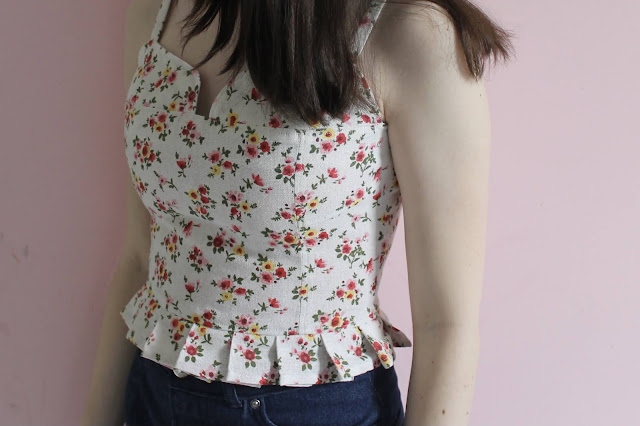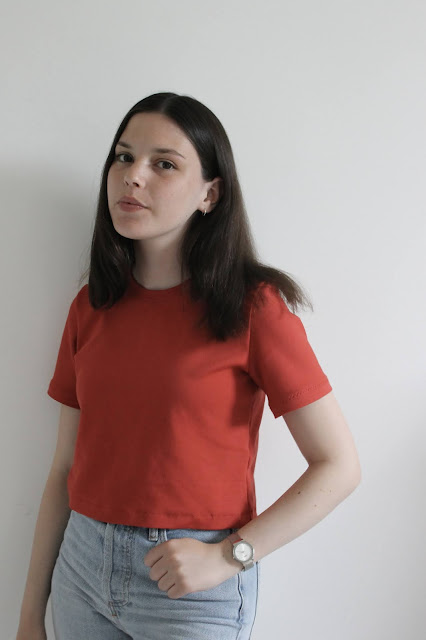Upcycling is a great way to make a new garment without having to purchase fabric, and also gives old clothes a new lease of life. Using old clothes gives me the freedom to self-draft a pattern without worrying about wasting fabric if it turns out badly. As well as upcycling old RTW clothes, refashioning old makes is also a great way to reuse fabrics. I often do this with clothes that I sewed a few years ago that weren't terribly well made, or that I no longer wear because my style has changed. Below is a round up of the garments that I've upcycled as well as tips on how to completely transform old clothes.

I had to begin with my
refashioned Hadley Top as it remains my favourite and proudest upcycling project three years on - and
I won a prize at the Knitting and Stitching Show for it! Jeans are the place to start when it comes to upcycling old clothes; they're easy to find in charity shops and denim is a nice stable fabric to sew with. The only tricky thing about using jeans as fabric is their width, so sewing projects with panels are ideal. For this top I used several different jeans to give a variety of denim shades and hacked my pattern into triangular pieces that were small enough to cut from the denim. Another thing I love about using old jeans is being able to keep their old features such as topstitching and pocket marks which I've incorporated throughout this top.

This skirt was my first upcycling project and shows another use for old jeans. With this project I only used one pair of jeans, but they were large enough to provide quite a bit of fabric. The skirt I made features several panels to allow for the fabric width.
When it comes to using old clothes pattern placement can be tricky depending on areas where the fabric is faded or stained. In this case, the jeans had a hole in them that I wasn't able to avoid as I didn't have enough fabric. To get around this I added a strip of fabric down the front, which covers up the hole and adds a decorative detail. The same could be achieved with
a patch or
visible mending.
When looking in charity shops for clothes to upcycle, it's best to focus on the fabric and not the style of the garment. Look for something which is too big and a fabric that you can imagine wearing. My dad gave me this grey long-sleeved t-shirt which is pretty uninteresting, but I knew that the plain fabric would be a good one to work with. Because the t-shirt was far too big for me I had enough fabric to turn it into a long-sleeved top for myself with an added ruched detail down the front.
Whilst buying clothes from a charity shop is a great way to start upcycling and means you can buy clothes with large pieces of fabric, upcycling old makes to ensure that the fabric isn't wasted. I made
this turtleneck when I first started sewing and enjoyed wearing it at the time but decided to make it into
a vest top once I no longer wore it. This is a great way of reusing old fabric that you still like and means you get a whole new garment from nothing.
The top on the left is one that I was really proud of when I first made it but wasn't wearing anymore a couple of years later. At the time I really liked the curved detail and was just starting to hack patterns, but I realised later that I would get more wear out of a simple t-shirt. In fact short-sleeved t-shirts are a great option for refashioning as they don't require a lot of fabric and - in my experience - get a lot of wear.

I mainly refashion clothes that I no longer like the style of, but upcycling also works really well for makes that don't turn out as anticipated. Sewing failures are inevitable, and I often leave move onto a new project and leave the less successful ones to quietly occupy space in my wardrobe.
This zip-neck jumper didn't turn out the way I was hoping, the fit was strange and the zip insertion wobbly. A year later I unpicked the entire thing and remade it into
this top and it's safe to say that the second version has been worn much more. The lack of fabric the second time round forced me to add in different panels and seams which are now my favourite features of the jumper,

Refashioning doesn't have to mean a full transformation into a different type of garment. I really liked the burgundy needlecord fabric that
my Delphine Skirt was made of but it didn't feel causal or summery enough to be worn often. I refashioned it by adding on trapezoid pockets and taking up the hem and it's now the skirt I reach for whenever it's hot out.
Upcycling tends to connote a full transformation but just changing the size of a garment to make it fit you counts. The large grey t-shirt that I turned into
this top came with a pair of pyjama bottoms which were also perfect for upcycling. I deconstructed the trousers entirely and used the same front and back pieces to cut new front and backs in my size. This doesn't always work as there has to be enough fabric but in omitting the pockets and using the original waistband I was able to make myself some joggers.

This is one of my favourite transformations that I've done. I had no idea whether or not it would work out but I love the final result. Despite being very proud of
my Dawn Jeans I wasn't really wearing them as I didn't love the length or the leg style. I hacked them into flares by inserting triangular pieces of fabric into the side seams and I'm so pleased with the how they turned out. My one disappointment is that the flares aren't longer, but I didn't have enough fabric left (the most frustrating thing in refashioning!).
Upcycling continues to be something that I enjoy doing, it's an easy way to try new sewing techniques and turn something unworn into something completely different. It's nice to think that with some of these makes I might be adding in a third transformation depending on how my style continues to evolve.





















